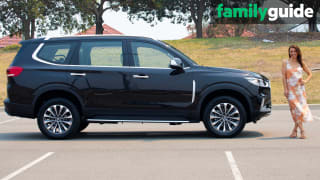
Why choose an Extra Cab ute instead of a Single Cab or Dual Cab?
- Ford Ranger
- Toyota HiLux
- Ford Commercial Range
- Ford Ute Range
- Toyota Commercial Range
- Toyota Ute Range
- Commercial
- Ute
- Ford Ranger Reviews
- Toyota HiLux Reviews
- Ford
- Toyota
- Tradie Advice
- Ford Advice
- Toyota Advice
- Towing
- Family Cars
- Tradies
- Tradie

If your top priority is having the longest load area, a Single Cab ute is the go. If regularly carrying passengers is important, then a Dual Cab (aka Double Cab/Crew Cab) is best. But what if your needs fall somewhere in between?
The Extra Cab option (aka Super Cab/King Cab/Club Cab/Space Cab) slots right in between a Single Cab and Dual Cab because it is, in effect, one-and-a-half cabins. This innovation can allegedly be traced back to US manufacturer Dodge in the early 1970s, when it added 18 inches (457 mm) of cabin length behind the seats and called it the Club Cab.
It was an instant hit and the idea was so good that virtually every light commercial ute manufacturer in the world now offers an Extra Cab option. And unlike those early designs, most extended cabs now feature a second set of doors that give unimpeded access to this rear space.
The Extra Cab offers a good compromise between load length, cabin space and the ability to carry more than one passenger. And, depending on your requirements, the Extra Cab can provide some practical advantages over a Single Cab or Dual Cab.
Advantages over a Single Cab
Extra space
The biggest single drawback of a single cab is limited space not only for storage of items but also in leg room for taller occupants, as the seat travel is limited. The dimensions of Extra Cabs vary but generally they add about 300 mm to the length of a Single Cab.
That results in a substantial boost in space that is secure and out of the weather. Some also feature hidden storage compartments in which to keep valuables away from prying eyes.
The Extra Cab’s longer roof can also offer a load-carrying advantage over a Single Cab
The Extra Cab offers great versatility, from being able to stow some overnight bags behind the seats on a weekend escape to a tradie that needs to carry lots of office-on-wheels stuff (plus the occasional worker or two) without losing all the extra load length that a Dual Cab eats into.
We’ve also seen some tradies’ Extra Cab utes fitted out with special cabinets tailor-made for office-on-wheels requirements, with laptop computers, documents and other equipment all nicely organised and locked away.
The Extra Cab’s longer roof can also offer a load-carrying advantage over a Single Cab, as roof racks can be mounted further apart to better support longer items.
Extra Passengers
You can transport kids or adults (of average height) in the back of an Extra Cab because there’s not only sufficient room but also separate passenger access doors. Although the ability to carry passengers can be very handy, there are some issues you need to be aware of.
Even though full lap-sash belts are usually provided, the seat cushions and backrests tend to be made from thin padding with no head restraints fitted. The restricted space also dictates a very upright seating position that concentrates upper body weight on the base of the spine, so this rudimentary seating is only designed for occasional short distance or emergency use.
At least the driver and front passenger can remain seated without having to step out and tilt their seats forward
Rear boarding and departing can also become tedious if you have to carry passengers regularly. Usually the rear doors can only be opened after the front seat belts are released (as they are anchored to these rear doors) and the front doors opened first, as they overlap the rears.
So it’s sort of like a two-door coupe or hatchback, but at least the driver and front passenger can remain seated without having to step out and tilt their seats forward like you have to do in a two-door passenger car.
Extra grade
Single Cab utes, be they 4x2 or 4x4, tend to have a work-only focus which generally restricts model choice to the lowest grades. For example, Ford Ranger Single Cabs are available only in base XL grade and Toyota Hilux Single Cabs come only in the base WorkMate level. However, Extra Cabs tend to offer more choice with higher grades of trim and features.
Extra shade
In a Single Cab ute the rear window is directly behind the seats. On hot summer days, with the afternoon sun burning the back of your head, ears and neck, it can be very unpleasant. However, the greater length of an Extra Cab provides a crucial buffer between front seat occupants and the rear window, which can largely alleviate this problem.
Advantages over a Dual Cab
Extra load length
The load floor length of an Extra Cab ute’s pick-up body or drop-side tray is generally around 300mm (or the length of a school ruler) longer than that of its Dual Cab equivalent, which could mean the difference between carrying longer items with the tailgate closed or open. The Extra Cab’s shorter length also means that more of the payload is in front of the rear wheels, resulting in more desirable weight distribution.
Extra payload
The Extra Cab is lighter than its Dual Cab equivalent which can also result in a useful gain in payload capacity. For example, the latest PXII Ford Ranger XLT 4x4 3.2L Extra Cab offers a 50 kg reduction in kerb weight compared to the Dual Cab version - and a 50 kg payload increase as a result.










Comments